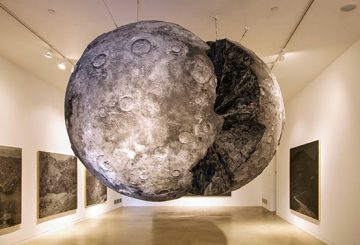Isobel Philip visited Gallery 9 to catch Julian Hooper‘s Golden Solvent and discovered that it’s all about the art of the reveal…
Viewing Julian Hooper’s show Golden Solvent at Gallery 9 was, for me, about process. Entering the gallery, you walked into an empty white corridor. The galleries branch off from this corridor and the works in each gallery were somewhat obscured by corners and angles. The sensation of walking into an empty space is a strange introduction to an art exhibition predicated on the presence of things to be seen. At Gallery 9 you have to find before you see.
Acrylic on linen, 180cm x 130cm.
The exhibition unraveled gradually. There were only two works in the first room, four in the second, and three in the third. There was also one work in the corridor, but you couldn’t see it from the entrance. The viewer, guided by the space, discovered the show. The works’ premise – the conflation of genre – was something you happened upon it. The figures that inhabit these paintings are assembled from fruit, flowers, sea creatures and other objects. Still life dissolves into portraiture in a minimalist echo of the 16th Century master Giuseppe Acrimboldo’s paintings.
Had all the works been presented en masse in one large space, making this premise blindingly obvious, I don’t think I would have engaged with the images as much as I did. It would have been a ‘got it, tick, so what?’ moment. Instead, the premise was teased out. In any case, this was what it was like for me – it was about the reveal.
This may have been due to the fact that I was quite distracted by the tail end of a conversation with a friend in the first room and didn’t linger long enough to notice that these artfully arranged objects in an undefined spatial field made up of overlapping panes of semi-transparent colour were actually pseudo-portraits. It was only in the second room that I got it; light bulb.
These figures (once I saw them as such) are remarkably graceful, their postures almost regal. They are the undisputed sovereigns of this formless kingdom (well, all but two, which configure scenes set on what appears to be a balcony), one that reminded me on first glance of the spatial plane within de Chirico’s painting – a spatial plane that alludes to, I’ve always thought, emptiness above all else.
Hooper’s space is made up of thin, coloured, transparent layers – as if each layer has begun to dissolve (another dissolve). Perhaps it was this that made me think of de Chirico, for as I stood there, I was palpably aware that these spaces – or non-spaces – were on the edge of dissolving into nothingness. Some of the figures were also transparent, like the couple, caught mid embrace, in Nocturne.
I rather liked this, being witness to something on the edge of dissolution, for it made the paintings – which at first can appear somewhat severe, because of the figures’ stiff posture and the clashing bright colours – seem slightly more fragile. To see this fragility you had to look closely at the paintings and gaze through the layers of paint.
Realizing this was another reveal, another light bulb, in this process-driven moment. But what else should I have expected? Wasn’t I forewarned? For isn’t a solvent, the agent of dissolution, nothing but the catalyst of a process?



working with space is always a winner for me.
thanks
i’ll check it out